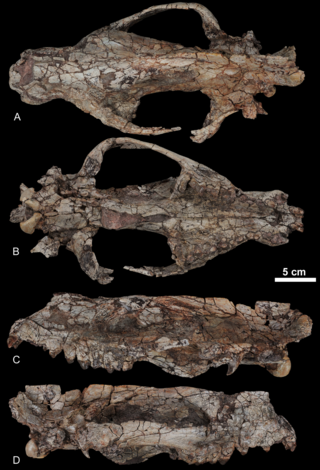
Creodonta is a former order of extinct carnivorous placental mammals that lived from the early Paleocene to the late Miocene epochs in North America, Europe, Asia and Africa. Originally thought to be a single group of animals ancestral to the modern Carnivora, this order is now usually considered a polyphyletic assemblage of two different groups, the oxyaenids and the hyaenodonts, not a natural group. Oxyaenids are first known from the Palaeocene of North America, while hyaenodonts hail from the Palaeocene of Africa.

Megistotherium is an extinct genus of hyaenodont belonging to the family Hyainailouridae that lived in Africa.

Dissopsalis is a genus of teratodontine hyaenodonts of the tribe Dissopsalini. The older species, D. pyroclasticus, lived in Kenya during the middle Miocene, while the type species, D. carnifex, lived in Pakistan and India during the middle to late Miocene.

Pterodon is an extinct genus of hyaenodont in the family Hyainailouridae, containing five species. The type species Pterodon dasyuroides is known exclusively from the late Eocene to the earliest Oligocene of western Europe. The genus was first erected by the French zoologist Henri Marie Ducrotay de Blainville in 1839, who said that Georges Cuvier presented one of its fossils to a conference in 1828 but died before he could make a formal description of it. It was the second hyaenodont genus with taxonomic validity after Hyaenodon, but this resulted in taxonomic confusion over the validities of the two genera by other taxonomists. Although the taxonomic status of Pterodon was revised during the late 19th and early 20th centuries, it became a wastebasket taxon for other hyaenodont species found in Africa and Asia. Today, only the type species is recognized as belonging to the genus while four others are pending reassessment to other genera.

Proviverra is an extinct genus of placental mammals from extinct family Proviverridae within extinct superfamily Hyaenodontoidea, that lived during the Middle Eocene in Europe.

Lesmesodon is an extinct genus of placental mammals from extinct family Proviverridae within extinct superfamily Hyaenodontoidea, that lived during the Early to Middle Eocene. It was found in France and in the Messel Pit in Germany. Lesmesodon was a weasel-sized carnivorous mammal.

Hyainailouros ("hyena-cat") is an extinct polyphyletic genus of hyaenodont belonging to the family Hyainailouridae that lived during the early to middle Miocene, of which there were at least three species spread across Europe, Africa, and Asia.

Apterodon is an extinct genus of hyaenodontid mammals that lived from the late Eocene through the middle Oligocene epoch in Africa and Europe. It is closely related to the African Quasiapterodon, and together it, they comprise the hyainailurid subfamily Apterodontinae.

Hyaenodonta is an extinct order of hypercarnivorous placental mammals of clade Pan-Carnivora from mirorder Ferae. Hyaenodonts were important mammalian predators that arose during the early Paleocene in Europe and persisted well into the late Miocene.

Hyainailouridae ("hyena-cats") is a family of extinct predatory mammals within the superfamily Hyainailouroidea within extinct order Hyaenodonta. Hyaenodontids arose during the middle Eocene and persisted well into the middle Miocene. Fossils of this group have been found in Asia, Africa, North America and Europe.

Teratodontinae is a subfamily of extinct hyaenodonts. Fossil remains of these mammals are known from Middle Eocene to Late Miocene deposits in Africa, the Arabian Peninsula, and Asia.
Altacreodus is an extinct genus of eutherian mammals. Fossils have been found in North America where they first appeared during the Late Cretaceous, and they died out prior to the start of the Paleocene. It is possibly one of the earliest known placental mammals in the fossil record.

Eurotherium is an extinct paraphyletic genus of placental mammals from extinct family Hyaenodontidae that lived from the early to middle Eocene in Europe.

Kerberos ("Cerberus") is an extinct genus of hyainailourid hyaenodonts in the subfamily Hyainailourinae, that lived in Europe. It contains the single species Kerberos langebadreae.

Limnocyoninae is a subfamily of extinct predatory mammals from extinct order Hyaenodonta. Fossil remains of these mammals are known from late Paleocene to late Eocene deposits in North America and Asia. Limnocyonines had only two molars in the upper and lower dentition.

Sinopidae is an extinct family of predatory placental mammals from extinct order Hyaenodonta. Fossil remains of these mammals are known from early to middle Eocene deposits in North America, Europe and Asia.

Hyaenodontoidea is a superfamily of extinct predatory mammals from extinct order Hyaenodonta. Fossil remains of these mammals are known from early Eocene to early Miocene deposits in North America, Europe and Asia.

Dissopsalini is an extinct tribe of teratodontid hyaenodonts. Fossil remains of these mammals are known from early to late Miocene deposits in Asia and Africa.

Apterodontinae is an extinct subfamily of hyainailourid hyaenodonts that lived in Africa and Europe during the late Eocene to middle Oligocene.

Hyainailourinae ("hyena-cats") is an extinct subfamily of hyainailourid hyaenodonts that lived in Africa, Asia, North America and Europe from the middle Eocene to middle Miocene. They appeared in Africa about 47.8 Ma ago and soon after spread as far as East Asia.














